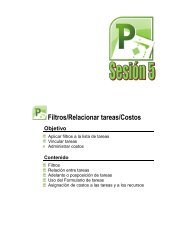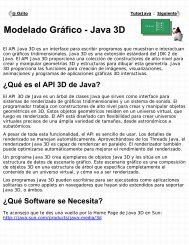Gráficos Con Java 2D - Abaco
Gráficos Con Java 2D - Abaco
Gráficos Con Java 2D - Abaco
Create successful ePaper yourself
Turn your PDF publications into a flip-book with our unique Google optimized e-Paper software.
Las siguientes líneas transforman el TextLayout para que sea centrado en el origen y luego<br />
introduce el objeto Shape resultante de la llamda a getOutline dentro del array shapes.<br />
AffineTransform textAt = new AffineTransform();<br />
textAt.translate(0,<br />
(float)textTl.getBounds().getHeight());<br />
shapes[2] = textTl.getOutline(textAt);<br />
Podemos elegir un primitivo accediendo al índice apropiado dentro del array shapes.<br />
Shape shape =<br />
shapes[Transform.primitive.getSelectedIndex()];<br />
Cómo se realiza el dibujo dependen de las opciones elegidas.<br />
● Cuando el usuario elige stroke, se llama a Graphics<strong>2D</strong>.draw para realizar el dibujo, Si se elige text<br />
como primitivo, las líneas son recuperadas y el dibujo se hace con el método draw.<br />
● Cuando el usuario elige fill, se llama a Graphics<strong>2D</strong>.fill o Graphics<strong>2D</strong>.drawString para realizar el<br />
dibujado.<br />
● Cuando el usuario elige stroke and fill, se llama a fill o drawString para rellenar el Shape, y luego<br />
se llama a draw para dibujar la línea exterior.<br />
Nota:<br />
Para rellenar y puntear un gráfico primitivo, necesitamos hacer dos llamadas separadas a<br />
métodos: fill o drawString para rellenar el interior, y draw para dibujar el exterior.<br />
Los tres estilos de línea usados en este ejemplo -- ancho, estrecho y punteado -- son ejemplares de<br />
BasicStroke.<br />
// Sets the Stroke.<br />
...<br />
case 0 : g2.setStroke(new BasicStroke(3.0f)); break;<br />
case 1 : g2.setStroke(new BasicStroke(8.0f)); break;<br />
case 2 : float dash[] = {10.0f};<br />
g2.setStroke(new BasicStroke(3.0f,<br />
BasicStroke.CAP_BUTT,<br />
BasicStroke.JOIN_MITER,<br />
10.0f, dash, 0.0f));<br />
break;<br />
El estilo de punteado de este ejemplo tiene 10 unidades de punteado alternados con 10 unidades de<br />
espacio. El principio del patrón del punteado se aplica al principio de la línea -- la fase de punteado<br />
es 0.0.<br />
En este ejemplo se usan tres estilos de dibujo -- sólido, gradiente y polka. El dibujo de color sólido<br />
es un ejemplar de Color, el gradiente un ejemplar de GradientPaint, y el patrón un ejemplar de<br />
TexturePaint.<br />
// Sets the Paint.<br />
...<br />
case 0 : g2.setPaint(Color.blue); break;<br />
case 1 : g2.setPaint(new GradientPaint(0, 0,<br />
Color.lightGray,<br />
w-250, h, Color.blue, false));<br />
break;<br />
case 2 : BufferedImage bi = new BufferedImage(5, 5,<br />
BufferedImage.TYPE_INT_RGB);<br />
Graphics<strong>2D</strong> big = bi.createGraphics();<br />
big.setColor(Color.blue);<br />
big.fillRect(0, 0, 5, 5);<br />
big.setColor(Color.lightGray);<br />
big.fillOval(0, 0, 5, 5);<br />
Rectangle r = new Rectangle(0,0,5,5);<br />
g2.setPaint(new TexturePaint(bi, r));<br />
break;





